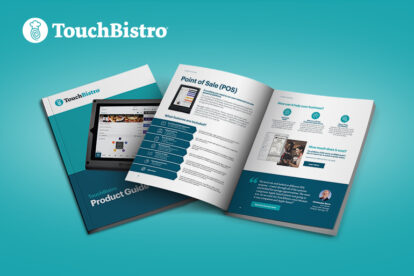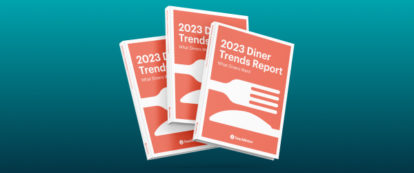If you’re shopping for a new POS system, one of the first decisions you need to make is choosing between a legacy POS system and a cloud POS system.
Legacy POS systems, also known as traditional POS systems, store your data on-site on local servers and run on a closed internal network. On the other hand, cloud-based POS systems are web-hosted solutions that store your data in the cloud via remote servers.
While there are pros and cons to each type of system, you might decide that legacy POS systems are a better fit for your particular restaurant. If that’s the case, the next step is actually finding a legacy POS that works for your restaurant (and your budget).
To help you cut through the noise and make shopping for a new POS a little less painful, we’ve put together an ultimate guide to the best legacy POS systems for restaurants. With in-depth restaurant POS system reviews of all the top legacy providers, this guide will help you narrow down the best restaurant POS for your specific business. This guide also includes a review of one of the top modern POS systems, TouchBistro, so you can see how a cloud-based system compares.
In each review, you’ll find:
- A basic overview of each of the top legacy POS systems for restaurants and one modern POS system
- Each system’s strengths and weaknesses
- Your payment processing options
- Software pricing and other fees
- The ideal restaurant for each POS system
We know that no restaurant POS system is a one-size-fits-all solution, which is why we’ve covered multiple different legacy POS systems, and one modern solution. We hope that with this guide to the best legacy POS systems, you’ll find the answers you need to choose a new POS system for your restaurant.

Compare the top legacy POS systems for restaurants on features, hardware, integrations, pricing, and more.
NCR Aloha
Overview
The Aloha POS has been around for quite some time and originally established a reputation as one of the top legacy POS systems. In 2011, Aloha’s parent company Radiant Systems was acquired by NCR Corporation, (previously known as National Cash Register). Since that time, NCR has made an effort to modernize the Aloha POS to compete with newer cloud-based POS solutions. Today, NCR Aloha is a popular option for major enterprise-level restaurant chains.
Strengths
Some of the strengths of the Aloha POS system include:
- The Aloha POS was designed for enterprise, which means that Aloha’s core features come with all the bells and whistles you could possibly want from a restaurant POS, and can even be customized to fit your exact needs.
- Aloha is used in more than 180 countries around the world, which is a major plus for any global restaurant brand that is looking to roll out one POS system across all of its international locations.
Weaknesses
Some of the drawbacks of the Aloha POS system include:
- Aloha’s hardware and monthly software fees are more expensive than many of its competitors because the system is designed for enterprise and not for the average independent restaurant.
- Most of Aloha’s hardware runs on Windows and Android operating systems, which come with steep learning curves – factors that may make the training process difficult and more time-consuming.
- Though most modern POS companies offer 24/7 support, Aloha’s Help Desk is only available to contact from 8 a.m. to 12 a.m. Central Time.
Payments
NCR, Aloha’s parent company, is a leader in banking and ecommerce and offers its own integrated payment processing solution for the Aloha POS called NCR Merchant Solutions. NCR Merchant Solutions is an end-to-end payments processor with the ability to process everything from mobile payments to card-not-present transactions, making it a good payments option for restaurants.
However, NCR is not very transparent when it comes to its actual payment processing fees. Though the company does promise competitive fees, you need to contact NCR directly if you want to know what you’ll actually be paying for payment processing each month. For restaurants that don’t want to go through the rigamarole of a sales pitch, this lack of transparency can be off putting.
Pricing
Unfortunately, there is also a lack of transparency when it comes to pricing for NCR Aloha’s software and hardware. NCR does not make any pricing information available publicly on its website, which means you must contact the company in order to get a quote for the Aloha POS system. The idea behind this model is that without fixed pricing packages, NCR can provide each restaurant with a custom rate for its specific POS setup. However, even with a custom rate, keep in mind that the Aloha POS is designed for enterprise and you should expect it to come with a price tag to match.
The Best POS For: Global QSRs and FSRs Brands
The Aloha POS is one of the most feature-rich systems on the market, making it an excellent option for enterprise-level restaurant brands. This lengthy feature list includes very robust multi-unit management tools that are especially valuable for restaurant brands with hundreds to thousands of locations. And with NCR’s vast global footprint, you could easily use the Aloha POS in international venues as well.
Of course, like any enterprise system, the Aloha POS does not come cheap. Though Aloha offers custom rates, it’s fees are much higher than most modern POS software subscriptions. And when you factor in the added cost of maintaining Aloha’s older legacy hardware, cost can quickly become a deal-breaker for most restaurants, especially small to medium-sized independent venues.
Wondering how NCR Aloha compares to TouchBistro?
Read our full review of TouchBistro vs NCR Aloha
Silverware
Overview
Silverware is a Canadian POS company that was founded back in 1992. Originally a legacy POS system, Silverware has since added cloud capabilities to its Windows and Android-based system, including an iOS app. Beyond restaurants, Silverware POS is also a popular choice for hotels and other hospitality businesses.
Strengths
Strengths of the Silverware POS system include:
- Silverware’s core POS features are very robust and come with a lot of bells and whistles that other POS providers lack, such as multi-unit management features that make it easy to track and manage multiple venues in one system.
- SIlverware does not require its customers to use one specific payment processing partner, meaning customers have the freedom to shop around for the best rate – a major plus for any budget-conscious restaurateur.
Weaknesses
Weaknesses of the Silverware POS system include:
- While most modern POS systems offer advanced reporting and analytics, Silverware’s reports are still limited to basic Excel-based files.
- Unlike other POS providers that include integrations at no extra cost, Silverware charges monthly per integration fees for every individual API – fees that can quickly add up if you use a lot of third-party integrations.
- Silverware’s legacy POS system was originally developed back in the 1990s and its technology still lags behind some of the newer systems on the market.

Compare the top legacy POS systems for restaurants on features, hardware, integrations, pricing, and more.
Payments
As mentioned above, a big plus of using Silverware POS is the freedom to choose from a wide variety of integrated payment processing partners, including big names like Chase Paymentech. This is a benefit to just about any restaurateur because it means you can go with the payment processor who provides the best rate for your specific restaurant type, your size, and the transaction volume you process.
While Silverware works with a lot of great payment processing partners, it’s worth noting that Silverware does not have its own in-house payments solution. While this it’s necessarily a drawback, some restaurateurs may prefer the option to use an in-house payment solution because these partners are industry-experts with services tailored specifically to the needs of restaurants.
Pricing
When it comes to pricing, SIlverware’s software fees start at $49 per month, and are mostly in line with that of other restaurant POS providers. However, it’s worth noting that Silverware’s most basic package lacks many important features, such as real-time cloud reporting, real-time cloud backup, and real-time system failover.
It’s also important to remember that while Silverware’s prices may seem reasonable, there are some additional fees associated with this legacy POS system. For instance, you may need to invest in proprietary hardware to run Silverware’s Windows or Android operating system. You also need to factor in the cost of every third-party integration you plan to use with your Silverware POS.
The Best POS For: Enterprise-Level Restaurant and Hospitality Brands
At the end of the day, there’s no question that SIlverware is a robust POS system with features that have been designed to handle the complex demands of high volume transactions associated with larger venues. As a result, Silverware is a great option for enterprise-level restaurant brands and hospitality venues like hotel chains.
While Silverware’s features may have all the bells and whistles, the actual technology still lags behind that of many modern POS systems. For independent FSRs and QSRs that need to be quick, agile, and flexible, Silverware’s older and sometimes glitchy software may be a hindrance to growth.
Wondering how Silverware compares to TouchBistro?
Read our full review of TouchBistro vs Silverware
Oracle MICROS Simphony POS
Overview
Micros (formally known as the Oracle MICROS Simphony POS system), was originally founded back in the 1970s as a high-tech alternative to the cash register. Micros was eventually purchased by Oracle Corporation, which has augmented the older legacy POS system with cloud capabilities. Micros is now a popular choice for well established, global restaurant chains, such as Pizza Hut, TGI Fridays, and Outback Steakhouse.
Strengths
Strengths of the Micros POS system include:
- Because Micros was designed for enterprise, the POS system’s core features are extremely robust and go a bit beyond what you would get with other restaurant POS systems.
- Micros supports integrations with more than 85 different third-party partners, including many regionally-specific partners that allow you to carry out niche functions in different international markets.
Weaknesses
Drawbacks of the Micros POS system include:
- Micros’ robust features and extensive add-ons can make the system overwhelming, and ultimately make it more difficult for staff to carry out basic tasks on a day-to-day basis.
- Micros isn’t very transparent with its pricing and its monthly software fees are generally on the high end because the system is specifically designed for enterprise restaurant brands.
- Since the legacy POS was purchased by Oracle, many reviews note that the quality of customer support has suffered.
Payments
Like other legacy POS systems, Micros offers quite a bit of flexibility when it comes to payment processing. In the past, Micros has worked with Heartland Payment Systems to create an easy integration between credit card processing and the Micros POS. However, Micros doesn’t currently require customers to use any one particular processor. This means that you have the freedom to choose from a wide variety of integrated payment processing partners and can shop around to find the best rate for your business.
Pricing
As mentioned, Micros is not very transparent when it comes to its pricing and requires anyone interested in the system to call in to receive a custom quote. The problem with this process is that restaurateurs have no baseline to decide whether Micros will be in their price range in the first place. This means that many will call in only to find out that the POS system is way out of their budget. And for busy restaurateurs, time is money.
The Best POS For: Global Restaurant Brands
Overall, it’s clear that the Micros POS is best for well established, global restaurant chains with hundreds, if not thousands, of locations around the world. The legacy POS system is equipped with extensive features, add-ons, and integrations designed to support and manage multiple locations. Not to mention, the system also supports multiple languages and currencies, which is something that’s essential to any global enterprise.
Of course, most venues don’t actually need extremely robust features, and support for multiple languages and currencies. As a result, most independent restaurants will find that Micros’ powerful capabilities are more than they need to run their operation and the price tag may be too high for features they won’t actually end up using.
Wondering how the Oracle MICROS Simphony POS compares to TouchBistro?
Read our full review of TouchBistro vs Micros POS
Squirrel Systems
Overview
Squirrel, formally known as Squirrel Systems, is a Canadian POS company that launched the first-ever touchscreen POS for the hospitality industry in 1984. Since then, the company has augmented its legacy POS system with cloud capabilities, and has developed a reputation as a trusted solution for restaurant groups and other major hospitality brands.
Strengths
Strengths of the Squirrel Systems POS include:
- Squirrel offers a broad range of hardware options and even allows you to “bring your own device.”
- Based on publicly available reviews, Squirrel’s 24/7 support team is often praised for being quick to respond and helpful in providing solutions.
Weaknesses
Drawbacks of the Squirrel POS include:
- Squirrel still runs on Windows and Linux, which means it lags behind some of the newer POS systems in terms of its technology.
- Unlike many of the other POS providers on the market, Squirrel does not have its own in-house solutions for important functions such as online ordering, reservations, or kitchen display systems.
- Primarily designed for major hospitality brands like hotels and casinos, rather than indepdendent restaurants.

Compare the top legacy POS systems for restaurants on features, hardware, integrations, pricing, and more.
Payments
Like many other legacy POS systems, Squirrel Systems does not offer its own in-house payment processing solution. Instead, you have the freedom and flexibility to choose from a lengthy list of integrated payment processing partners. For many restaurateurs, this is a major plus because it means you can shop around, compare rates, and ultimately choose the best payment processing for your specific business model.
Pricing
Squirrel’s pricing is based on how many POS terminals you need, which means the bigger your venue, the higher your monthly software fees. This pricing structure is designed to accommodate venues of various sizes, however, it’s worth noting that Squirrel Systems is primarily used by major restaurant groups and hospitality brands that generally require a multi-terminal setup.
The Best POS For: High-Volume Restaurants
With a robust set of core features, flexible payment processing options, multi-location management, and a range of third-party integration partners, Squirrel is a great fit for high volume operations in the restaurant and hospitality space. Squirrel’s broad range of available hardware is also a plus for major restaurant groups that may need different hardware options for different concepts.
But while Squirrel’s core POS may be strong, the system is lacking when it comes to in-house add-ons like reservations, online ordering, marketing, and more. For many growing restaurants, in-house add-ons are preferable to third-party solutions because they help to extend the capabilities of the core POS without the risk of errors or hefty third-party fees. And with Squirrel’s software fees already on the high end, most independent restaurants won’t have the budget to pay for extra third-party solutions.
Wondering how Squirrel Systems compares to TouchBistro?
Read our full review of TouchBistro vs Squirrel Systems
TouchBistro
To help you compare the legacy providers in this guide to a modern solution, we’ve included a review of one of the top modern restaurant POS systems, TouchBistro.
Overview
TouchBistro is an award-winning iPad POS system and integrated payment processing solution built for restaurant people, by restaurant people. Used in Canada, the U.S., the U.K., Mexico, and over 100 other countries, TouchBistro is one of the best restaurant POS systems for independent restaurants. It has even been featured as Gordon Ramsay’s POS system of choice on the hit show Gordon Ramsay’s 24 Hours to Hell and Back.
Strengths
Strengths of the TouchBistro POS system include:
- TouchBistro boasts a unique hybrid POS architecture, which means you enjoy all the convenience and remote capabilities of any other cloud POS, but there is also a hardwired, local connection that acts as a backup when the Internet goes down.
- TouchBistro’s core features and add-on solutions have been specially crafted to meet the unique demands of running a restaurant, such as taking orders tableside, processing online orders, and menu engineering.
- TouchBistro also offers an in-house restaurant reservations management system, which is something no other restaurant POS provider has.
- Unlike many other POS providers, TouchBistro’s in-house payment processing solution, TouchBistro Payments, is structured according to a cost plus pricing model.
Want to see TouchBistro in action?
Weaknesses
Some of the drawbacks of TouchBistro include:
- TouchBistro lacks some of the enterprise-level capabilities that many legacy POS systems offer, making it a less suitable option for major restaurant chains.
- Because TouchBistro is largely designed for independent restaurants and not major chains, it does not have an extensive network of third-party integration partners.
Payments
Unlike some of the other POS providers on the market, TouchBistro offers more flexibility when it comes to payment processing. TouchBistro partners with a number of other payment partners, like TSYS and Moneris in Canada, and Barclaycard in the U.K. This means you have a bit more freedom to go with the payment processing solution that fits your business model or your location-specific needs.
In addition to partnerships with third-party payment processors, TouchBistro also offers an integrated payments solution. In the U.S., customers can use TouchBistro Payments powered by Chase, which is an in-house, integrated payment processing solution. Unlike many other payment processors, TouchBistro Payments uses a cost plus pricing model. With a cost plus pricing model, factors such as the type of card a customer pays with, processing volume, and risk criteria are taken into consideration. This means you pay a custom rate for each transaction, instead of a flat rate for all transactions. The result? You get a more competitive rate than you would with fixed rate pricing.
Pricing
Not only are TouchBistro’s payment processing fees competitive, but so are its monthly software fees. TouchBistro’s software starts at $69 USD per month for a single license, and its pricing is tiered so the cost decreases for each additional license you add. With each package, you get all of TouchBistro’s core POS features, cloud-based reporting and analytics, 24/7/365 support, and unlimited users and logins for your staff and management.
Like other POS systems, you’ll also have to factor in additional costs to use TouchBistro such as installation, hardware, and payment processing fees (if you’re using integrated payments). Because TouchBistro is a restaurant iPad POS system, you may be able to save on some hardware costs by reusing your current iPad tablets (as long as it’s a compatible generation). TouchBistro also gives you the option to split the cost of your POS tablets over 24 months, which is a great alternative if you don’t want to purchase your iPads outright.
The Best POS For: Independent Restaurants
With all the POS features you need to run a restaurant, TouchBistro is a great all-around solution for independent restaurants big and small. And with in-house technology like loyalty and integrated reservations, TouchBistro is one of the best restaurant POS systems for both QSRs and FSRs.
Though TouchBistro can easily support larger restaurants, it’s not equipped with the kind of enterprise-level capabilities required to support nation-wide, multi-unit chains. For restaurants with these kinds of complex needs, a more bespoke legacy POS solution with multi-unit reporting capabilities would be a better fit.

Compare the top legacy POS systems for restaurants on features, hardware, integrations, pricing, and more.
The Bottom Line
It goes without saying that no legacy POS system – or modern POS system for that matter – is a one-size-fits-all-solution. Our ultimate guide to the best legacy POS systems is designed to highlight the pros and cons of each system so you can find a provider that offers the features, tools, and services you need to run a successful restaurant. Armed with this information, you’ll be better equipped to choose the best restaurant POS system for your particular venue.
Comparing POS systems? Get our Ultimate Guide
Free Resources for Restaurant Owners







